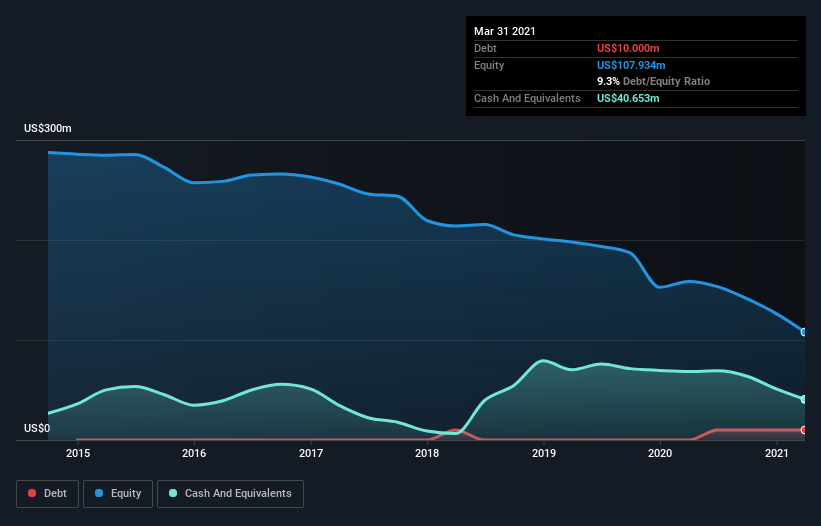Is Gulf Island Fabrication (NASDAQ:GIFI) A Risky Investment?
The external fund manager backed by Berkshire Hathaway's Charlie Munger, Li Lu, makes no bones about it when he says 'The biggest investment risk is not the volatility of prices, but whether you will suffer a permanent loss of capital.' So it might be obvious that you need to consider debt, when you think about how risky any given stock is, because too much debt can sink a company. We can see that Gulf Island Fabrication, Inc. (NASDAQ:GIFI) does use debt in its business. But is this debt a concern to shareholders?
Why Does Debt Bring Risk?
Debt assists a business until the business has trouble paying it off, either with new capital or with free cash flow. Part and parcel of capitalism is the process of 'creative destruction' where failed businesses are mercilessly liquidated by their bankers. However, a more usual (but still expensive) situation is where a company must dilute shareholders at a cheap share price simply to get debt under control. By replacing dilution, though, debt can be an extremely good tool for businesses that need capital to invest in growth at high rates of return. When we examine debt levels, we first consider both cash and debt levels, together.
See our latest analysis for Gulf Island Fabrication
How Much Debt Does Gulf Island Fabrication Carry?
The image below, which you can click on for greater detail, shows that at March 2021 Gulf Island Fabrication had debt of US$9.27m, up from none in one year. However, it does have US$40.7m in cash offsetting this, leading to net cash of US$31.4m.
How Strong Is Gulf Island Fabrication's Balance Sheet?
We can see from the most recent balance sheet that Gulf Island Fabrication had liabilities of US$100.8m falling due within a year, and liabilities of US$4.72m due beyond that. Offsetting this, it had US$40.7m in cash and US$89.5m in receivables that were due within 12 months. So it actually has US$24.7m more liquid assets than total liabilities.
This surplus liquidity suggests that Gulf Island Fabrication's balance sheet could take a hit just as well as Homer Simpson's head can take a punch. Having regard to this fact, we think its balance sheet is as strong as an ox. Succinctly put, Gulf Island Fabrication boasts net cash, so it's fair to say it does not have a heavy debt load! When analysing debt levels, the balance sheet is the obvious place to start. But ultimately the future profitability of the business will decide if Gulf Island Fabrication can strengthen its balance sheet over time. So if you're focused on the future you can check out this free report showing analyst profit forecasts.
Over 12 months, Gulf Island Fabrication made a loss at the EBIT level, and saw its revenue drop to US$231m, which is a fall of 26%. That makes us nervous, to say the least.
So How Risky Is Gulf Island Fabrication?
By their very nature companies that are losing money are more risky than those with a long history of profitability. And in the last year Gulf Island Fabrication had an earnings before interest and tax (EBIT) loss, truth be told. And over the same period it saw negative free cash outflow of US$28m and booked a US$52m accounting loss. But the saving grace is the US$31.4m on the balance sheet. That means it could keep spending at its current rate for more than two years. Overall, its balance sheet doesn't seem overly risky, at the moment, but we're always cautious until we see the positive free cash flow. When analysing debt levels, the balance sheet is the obvious place to start. However, not all investment risk resides within the balance sheet - far from it. These risks can be hard to spot. Every company has them, and we've spotted 2 warning signs for Gulf Island Fabrication (of which 1 doesn't sit too well with us!) you should know about.
If you're interested in investing in businesses that can grow profits without the burden of debt, then check out this free list of growing businesses that have net cash on the balance sheet.
This article by Simply Wall St is general in nature. It does not constitute a recommendation to buy or sell any stock, and does not take account of your objectives, or your financial situation. We aim to bring you long-term focused analysis driven by fundamental data. Note that our analysis may not factor in the latest price-sensitive company announcements or qualitative material. Simply Wall St has no position in any stocks mentioned.
Have feedback on this article? Concerned about the content? Get in touch with us directly. Alternatively, email editorial-team (at) simplywallst.com.

 Yahoo Finance
Yahoo Finance 
